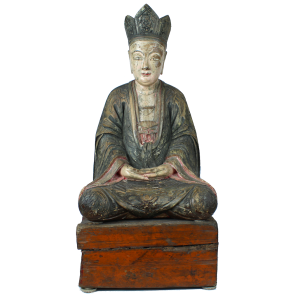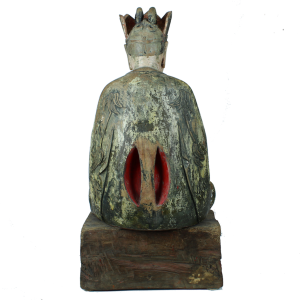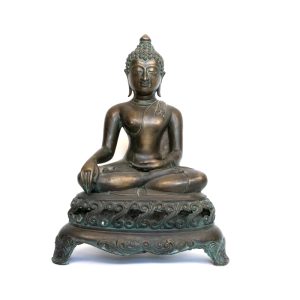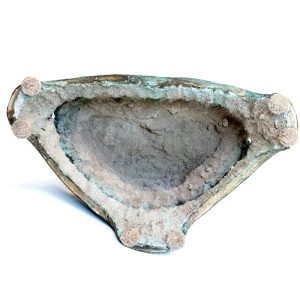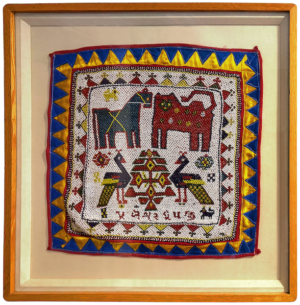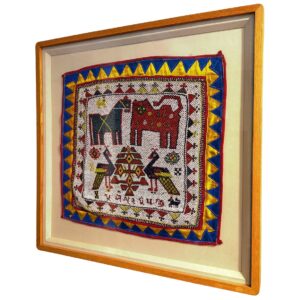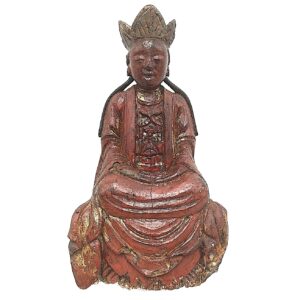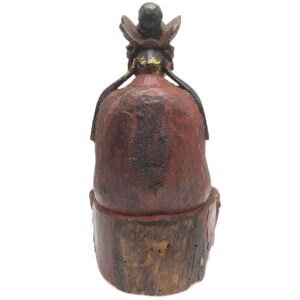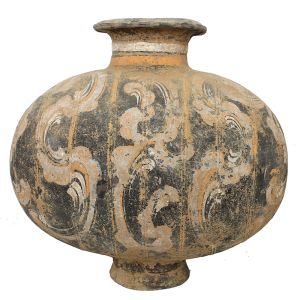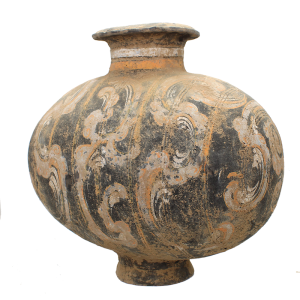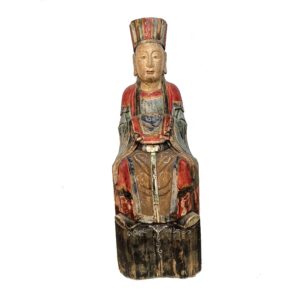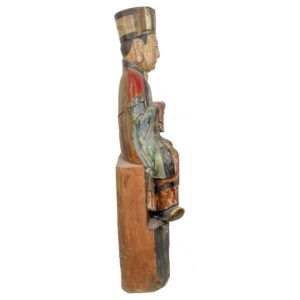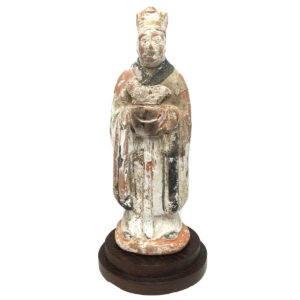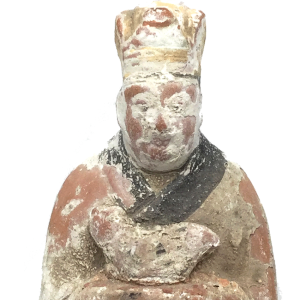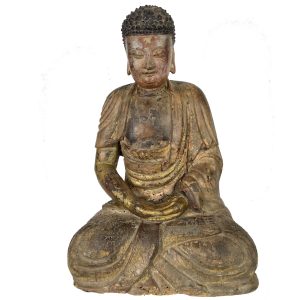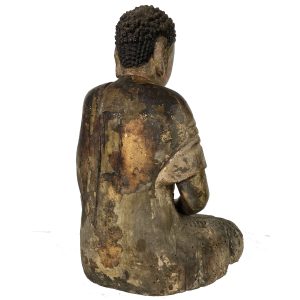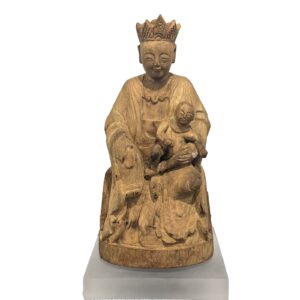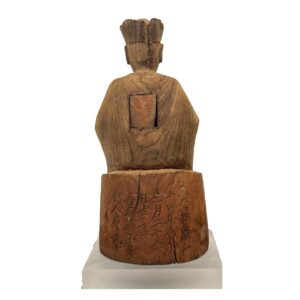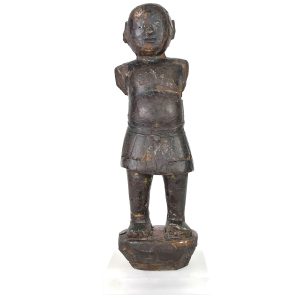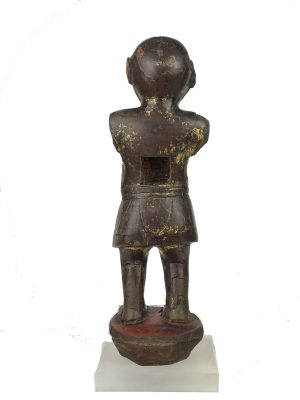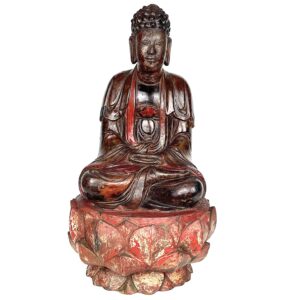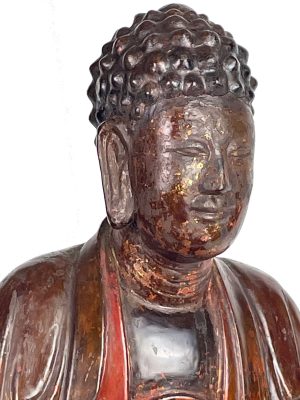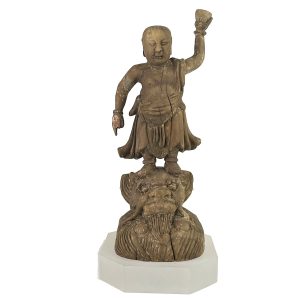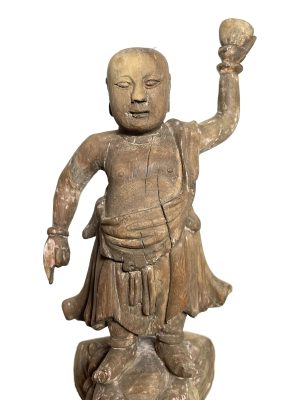Showing 157–168 of 248 results
-
Sale!


$4,450.00 Original price was: $4,450.00.$3,500.00Current price is: $3,500.00.
Ht: 27.5” W:13.5: D: 10.25” | CALL 213-568-3030 FOR SHIPPING QUOTE OR EMAIL US AT [email protected]
Magnificent example of fine provincial Buddhist statues. Made to be seen in the round, her garment has delicate incised leaves and leaf motifs on front, back, and sleeves. High pointed crown with the Five Tantric Dhyani Buddhas, rare in provincial Guanyins.
-
Sale!


$395.00 Original price was: $395.00.$295.00Current price is: $295.00.
H: 21” W: 15.5 ” D: 9.5” | CALL 213-568-3030 FOR SHIPPING
Thai bronze Lopburi style Buddha in Earth Witnessing position on decorative pierced throne on 3 footed curved base wearing simple 2-part Theravada Buddhist monk’s robe showing his modest religious devotion. Heavy statue filled with cement binder.
-
Sale!


$495.00 Original price was: $495.00.$395.00Current price is: $395.00.
H: 30″ W: 29.5″ D: 2.125″ | CALL 213-568-3030 OR EMAIL [email protected] FOR SHIPPING
Vintage beadwork tapestry with many auspicious Hindu symbols: Tree of Life, Monkey God Hanuman, a horse and pair of peacocks together symbolizing the cycle of life, spiritual growth, enlightenment, divine wisdom and beauty. Used in many Indian celebrations, they are also placed at home doorways and thresholds symbolizing warmth, positivity, and protection and invite blessings to the home.
-
Sale!


$425.00 Original price was: $425.00.$295.00Current price is: $295.00.
H:9.75″ W: 5.6″ D: 3.75″ | FREE SHIPPING WITHIN CONTINENTAL U.S.
Consecrated red lacquer and gilt home altar provincial Guanyin, elaborate 5-lobed crown centered with radiating bars symbolizing Amitabha Buddha and his aureole that represent the flames of Buddhism.
-
Sale!


$2,150.00 Original price was: $2,150.00.$1,785.00Current price is: $1,785.00.
H: 11.75” W: 12.25” CALL 213-568-3030 OR EMAIL [email protected] FOR SHIPPING.
Families placed cocoon jars with auspicious designs containing magical mixtures of mulberry leaves in tombs for departed’s souls to drink to transform in afterlife.
-
Sale!


$3,950.00 Original price was: $3,950.00.$3,400.00Current price is: $3,400.00.
H: 34″ W: 11″ D: 8″ | CALL 213-568-3030 OR EMAIL [email protected] FOR SHIPPING.
This masterfully carved and painted 18th century statue of a Taoist priest/official wears elaborate robes and a hat. His well-articulated face has strong features and solemn gaze, flanked by pendulous ears, the sign of a wise man. This exceptional image deserves the appropriate placement to optimize its outstanding presence.
-
Sale!


$395.00 Original price was: $395.00.$295.00Current price is: $295.00.
H: 3.375″ W: 2.75″ D: 2.5″ | FREE SHIPPING WITHIN CONTINENTAL U.S.
One of a set of 12 Zodiac attendant figures holding a small calendar animal of the year represented as part of mingqi placed in the graves of deceased.
-
Sale!


$3,200.00 Original price was: $3,200.00.$2,300.00Current price is: $2,300.00.
H: 14” W: 9.375” D: 7.25” | FOR SHIPPING INFORMATION CONTACT US AT 213-568-3030
Rare small yet majestic carving of the Buddha in meditation with gracefully draped robes and beautifully idealized features that radiates serenity, compassion and spirituality. A truly magnificent piece.
-
Sale!


$1,350.00 Original price was: $1,350.00.$1,100.00Current price is: $1,100.00.
H: 11” W: 5.75” D: 5.125” | FREE SHIPPING WITHIN CONTINENTAL U.S.
Very rare and fine 16th century home shrine image with compassionate countenance of Songzi Guanyin the “Bestower of Children.” With joyful half-closed eyes, she looks lovingly at the child whose arm is draped over hers.and leans slightly forward.Wearing a 5- lobed crown centered with a camellia flower a Chinese symbol of young sons and daughters. Inscription dates it to 1521-1567
-
Sale!


$985.00 Original price was: $985.00.$650.00Current price is: $650.00.
H: 17.5 W: 6” D: 5” | FOR SHIPPING Call 213-568-3030 or email [email protected]
Although this rare Ming image is missing its arms, it is a powerful yet charming sculpture of the infant Buddha as humble and confident with a youthful torso.
-
Sale!


$3,750.00 Original price was: $3,750.00.$2,985.00Current price is: $2,985.00.
H:18.75“ W: 9.75″ D: 9″ | CALL 213-568-3030 OR EMAIL [email protected] FOR SHIPPING.
Magnificent rare Ming Buddha covered with dark lacquer, indications of gold and red pigmentation. Seated in meditation on an elaborate lotus throne, this rare masterpiece would enhance any environment with its spiritual energy and beauty.
-
Sale!


$750.00 Original price was: $750.00.$575.00Current price is: $575.00.
H: 9″ W: 3.625″ D: 3.5″ | FREE SHIPPING IN CONTINENTAL U.S.
Ming provincial infant Buddha holding monk’s begging bowl, pointing to heavens standing on a lion’s head symbolizing the Shakya clan and the lion’s roar of Buddhism. Buddha images seldom placed in homes and blended iconography as an infant, is extremely rare.
End of content
End of content

